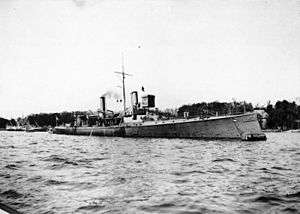SMS Meteor (1890)
 SMS Meteor at anchor | |
| History | |
|---|---|
| Name: | SMS Meteor |
| Builder: | Germaniawerft |
| Laid down: | 1888 |
| Launched: | 20 July 1890 |
| Commissioned: | 19 May 1891 |
| Fate: | Scrapped, 1919 |
| General characteristics | |
| Class and type: | Meteor-class aviso |
| Displacement: | 1,078 metric tons (1,061 long tons; 1,188 short tons) |
| Length: | 79.86 m (262 ft 0 in) o/a |
| Beam: | 9.56 m (31 ft 4 in) |
| Draft: | 3.68 m (12 ft 1 in) |
| Propulsion: | 2 × 3-cylinder double expansion engines, 2 shafts |
| Speed: | 20 knots (37 km/h; 23 mph) |
| Range: | 960 nmi (1,780 km; 1,100 mi) at 9 kn (17 km/h; 10 mph) |
| Complement: |
|
| Armament: |
|
| Armor: |
|
SMS Meteor was an aviso of the Imperial German Navy, the lead ship of her class. She had one sister ship, Comet. She was built by the Germaniawerft shipyard. Her keel was laid in 1888; she was launched in January 1890, and completed in May 1891. Her career was limited due to poor handling and excessive vibration; she remained on active service only until 1895. She was used as a harbor guard ship from 1904 to 1911, after which she became a barracks ship in Kiel. Meteor was sold for scrap in 1919 and subsequently dismantled.
Design
Meteor was 79.86 meters (262.0 ft) long overall and had a beam of 9.56 m (31.4 ft) and a maximum draft of 3.68 m (12.1 ft) forward. She displaced 1,078 metric tons (1,061 long tons; 1,188 short tons) at full combat load. Her propulsion system consisted of two vertical 3-cylinder triple expansion engines. Steam for the engines was provided by four coal-fired locomotive boilers. The ship's propulsion system provided a top speed of 20 kn (37 km/h; 23 mph) and a range of approximately 960 nautical miles (1,780 km; 1,100 mi) at 9 kn (17 km/h; 10 mph). Meteor had a crew of 7 officers and 108 enlisted men.[1]
As built, the ship was armed with four 8.8 cm SK L/30 guns placed in single pivot mounts, two side-by-side forward, and two side-by-side aft. The guns were supplied with between 462 and 680 rounds of ammunition. Meteor also carried three 35 cm (14 in) torpedo tubes, one mounted submerged in the bow and the other two in deck-mounted launchers on the broadside. She was protected with a 15 mm (0.59 in) thick deck, along with 30 mm (1.2 in) of steel armor plating for the conning tower.[1]
Service history

Meteor was laid down at the Germaniawerft shipyard in Kiel in 1888, and launched on 20 January 1890. Fitting-out work then commenced, and was completed by 19 May 1891, when she was commissioned into the German fleet. Meteor served with the fleet only briefly; this was due to her poor handling and excessive vibration at high speed.[2] In 1893, she was assigned as the dispatch vessel for the I Division of the Maneuver Squadron, which was composed of the four Sachsen-class ironclads.[3]
By 1895, she was withdrawn from front-line service and used for fishery protection. This duty lasted only a year, after which she was placed out of service.[1] In 1899, she was reclassified as a light cruiser, along with her sister ship Comet, though both vessels remained out of service.[4] Meteor was used as a harbor guard ship starting on 3 May 1904. On 24 June 1911, she was stricken from the naval register and used as a barracks ship in Kiel. She served in this capacity through World War I. After the German defeat, the ship was sold for scrapping in 1919. Meteor thereafter was broken up in Rendsburg.[1]
Notes
References
- Gardiner, Robert, ed. (1979). Conway's All the World's Fighting Ships: 1860–1905. London: Conway Maritime Press. ISBN 0-85177-133-5.
- Gardiner, Robert; Gray, Randal, eds. (1984). Conway's All the World's Fighting Ships: 1906–1922. Annapolis, MD: Naval Institute Press. ISBN 978-0-87021-907-8.
- Gröner, Erich (1990). German Warships: 1815–1945. Annapolis, MD: Naval Institute Press. ISBN 0-87021-790-9.
- "Naval and Military Notes". Journal of the Royal United Service Institution. London: Royal United Services Institute for Defence Studies. XXXVII (185): 811–823. July 1893. doi:10.1080/03071849309416563.